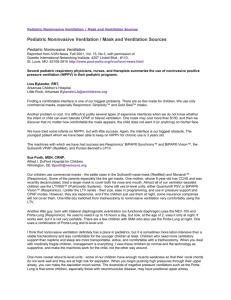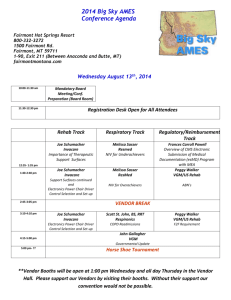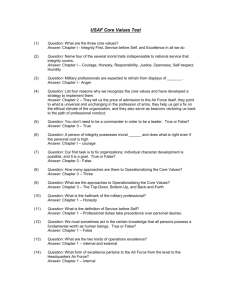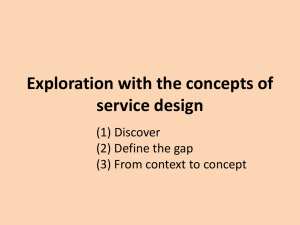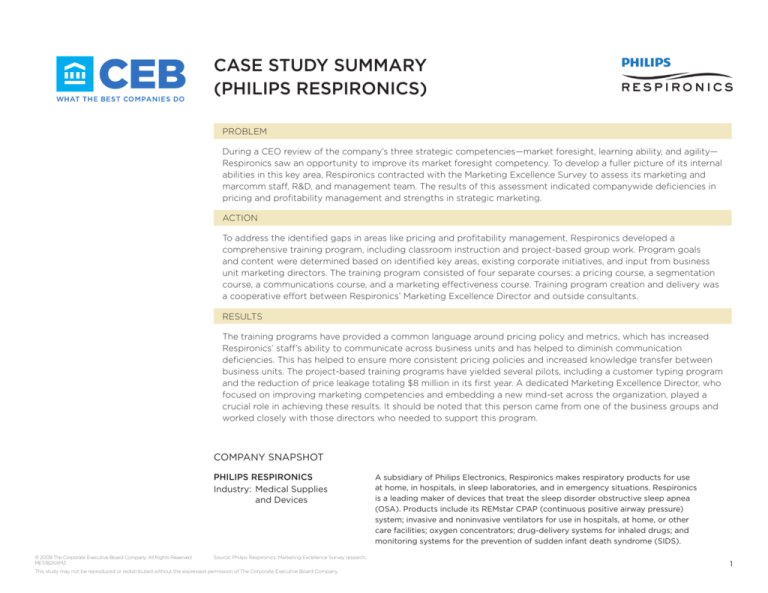
CASE STUDY SUMMARY
(PHILIPS RESPIRONICS)
PROBLEM
During a CEO review of the company’s three strategic competencies—market foresight, learning ability, and agility—
Respironics saw an opportunity to improve its market foresight competency. To develop a fuller picture of its internal
abilities in this key area, Respironics contracted with the Marketing Excellence Survey to assess its marketing and
marcomm staff, R&D, and management team. The results of this assessment indicated companywide deficiencies in
pricing and profitability management and strengths in strategic marketing.
ACTION
To address the identified gaps in areas like pricing and profitability management, Respironics developed a
comprehensive training program, including classroom instruction and project-based group work. Program goals
and content were determined based on identified key areas, existing corporate initiatives, and input from business
unit marketing directors. The training program consisted of four separate courses: a pricing course, a segmentation
course, a communications course, and a marketing effectiveness course. Training program creation and delivery was
a cooperative effort between Respironics’ Marketing Excellence Director and outside consultants.
RESULTS
The training programs have provided a common language around pricing policy and metrics, which has increased
Respironics’ staff’s ability to communicate across business units and has helped to diminish communication
deficiencies. This has helped to ensure more consistent pricing policies and increased knowledge transfer between
business units. The project-based training programs have yielded several pilots, including a customer typing program
and the reduction of price leakage totaling $8 million in its first year. A dedicated Marketing Excellence Director, who
focused on improving marketing competencies and embedding a new mind-set across the organization, played a
crucial role in achieving these results. It should be noted that this person came from one of the business groups and
worked closely with those directors who needed to support this program.
COMPANY SNAPSHOT
PHILIPS RESPIRONICS
Industry: Medical Supplies
and Devices
© 2009 The Corporate Executive Board Company. All Rights Reserved.
MES1B2XXMZ
Source: Philips Respironics; Marketing Excellence Survey research.
This study may not be reproduced or redistributed without the expressed permission of The Corporate Executive Board Company.
A subsidiary of Philips Electronics, Respironics makes respiratory products for use
at home, in hospitals, in sleep laboratories, and in emergency situations. Respironics
is a leading maker of devices that treat the sleep disorder obstructive sleep apnea
(OSA). Products include its REMstar CPAP (continuous positive airway pressure)
system; invasive and noninvasive ventilators for use in hospitals, at home, or other
care facilities; oxygen concentrators; drug-delivery systems for inhaled drugs; and
monitoring systems for the prevention of sudden infant death syndrome (SIDS).
1
FIVE KEYS TO SUCCESS
1
Align Participation with Work Projects
Respironics selected participants for the training based on project work and ensured the training was voluntary. This has helped
Respironics avoid participant resentment and increase engagement.
2
Build from Small Successes
Respironics received funding for a full-time Marketing Excellence program by developing a training program where successes
would be easily visible to a senior audience, such as with changes to pricing strategy.
3
Align with Corporate Objectives
By aligning the training to corporate objectives, Respironics kept its senior management supportive of the program. Every
training session included a “destination statement” at the beginning of the session to reorient learners back to corporate
objectives as a reason behind the training session.
4
Align with Business Unit Training Needs
By creating monthly feedback sessions with the Business Unit Marketing Directors, the Marketing Excellence Director shaped
training programs to reflect changing business unit priorities in the context of the larger corporate 0bjectives. The feedback
sessions also helped to ensure that the Marketing Directors remained supportive of the initiative.
5
Assign a Project Owner
Respironics felt that having a full-time staff member assigned to create, run, and track the training program was essential in
making sure that milestones and deliverables were hit and that there was a driving force behind the training program.
Source: Philips Respironics; Marketing Excellence Survey research.
© 2009 The Corporate Executive Board Company. All Rights Reserved.
MES1B2XXMZ
This study may not be reproduced or redistributed without the expressed permission of The Corporate Executive Board Company.
2
APPENDIX: TRAINING PROGRAM DETAILS
Inputs Used to Decide Training Topics
During the selection of training topics, Respironics reviewed
its key competencies, the vision of its CEO’s mandate, its
Marketing Excellence Survey results, and its business unit
training needs to determine a relevant and comprehensive
program.
External experts developed the training programs, and the
programs are customized to reflect the culture of the firm.
Respironics’ Marketing Excellence Director maintained regular
feedback with each business unit marketing director to
ensure that their training programs were staying aligned with
changing business unit priorities.
Training Program Structure
Four training programs were developed to address the
four selected training topics—pricing, segmentation,
communications, and marketing effectiveness.
Pricing and segmentation consisted of two days of class
instruction, a group project, and two more days of classroombased project review.
Respironics developed the program curricula in conjunction
with several outside consultants.
The outside consultant, acting as a subject matter expert,
or Respironics’ Marketing Excellence Director, facilitated the
training sessions.
Project groups were created randomly with cross-functional
staff from different business units. These project groups were
assigned to complete a project based on the business needs
identified prior to the session. It provided participants the
ability to work with other business teams outside of their own.
After a specified amount of time (several months), the groups
reconvened to present their project ideas and to receive
feedback from the program facilitator.
Source: Philips Respironics; Marketing Excellence Survey research.
© 2009 The Corporate Executive Board Company. All Rights Reserved.
MES1B2XXMZ
This study may not be reproduced or redistributed without the expressed permission of The Corporate Executive Board Company.
Participant Selection
Business unit marketing directors nominated participants
to attend the training.
Nominations were based on whether the employee had an
upcoming project that would be relevant to the training topic.
Nominations did not compel participation; participation
remained voluntary.
Business unit marketing directors also attended the training
to project their support for the program.
Applying Training Knowledge
Respironics selected the top projects from each training
session to create marketing pilots to apply the learned
knowledge and improve its processes.
After the pilot programs were selected, Respironics’ Marketing
Excellence Director moved to begin creating tools and
templates to help support and reinforce these new processes.
All tools were developed using members across business units
who attended training.
Respironics helped to cement the idea of applying learned
knowledge by honoring the top training-based projects at its
global marketing conference and providing attractive prizes.
Measuring Success
The MES survey was conducted a second time—18 months
after implementing training—to measure improvement in
marketing knowledge and attitudes and to evaluate the
effectiveness of its training programs. The team raised its
overall marketing knowledge 10 points and increased its areas
of need by 20 points each propelling Respironics into the top
20% of MES database scores in market analysis and marketing
profitability.
3


